The Power of Dirt
Gardening provides robust benefits to our physical, emotional, psychological, and social wellbeing.
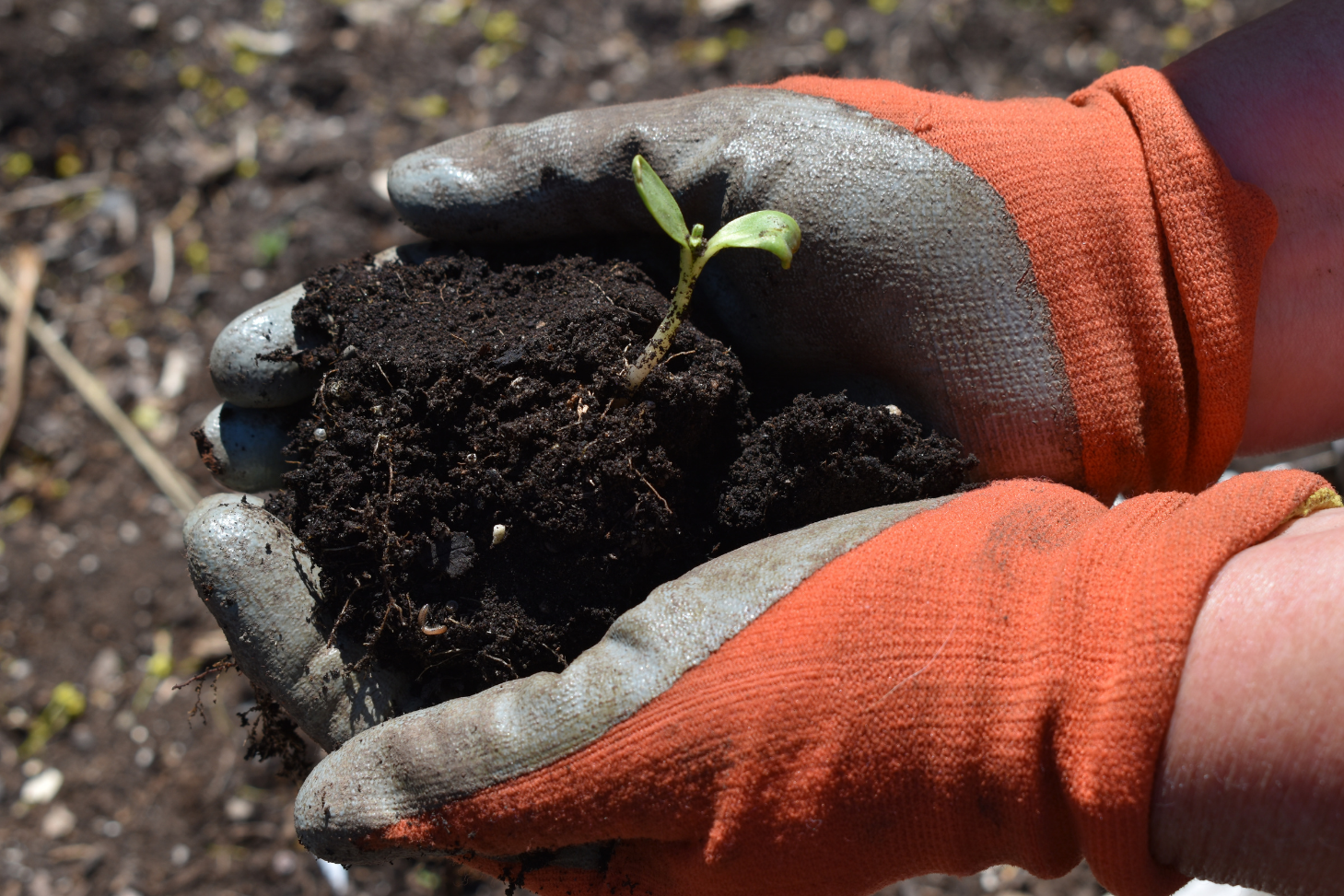

For 90 minutes, 66-year-old, silver-and-pink-haired Jane Marmaduke Woodman weaved in and around raised beds, container pots, and a very old hemlock tree across the two plots of land that surround her azure, two-story house in Elmwood, one of Syracuse’s 26 neighborhoods. She wore flip flops and a monochrome zip-up hoodie tied around her waist. Woodman pointed to soon-to-be towering asparagus plants, sprouting Glencoe purple raspberry vines, and stakes that marked where tomato plants grew last year. These note where to position trellises for vining crops for this year’s planting. Three structures made from recycled palettes housed stages of compost – a cycle of new, old, and squash compost. Squash grows best in compost, a fact she knows because she’s learned from the earth, the plants, and herself. Her 77-year-old husband John, donning worn-in blue jeans and Jane’s “Make America Not Embarrassing Again” hat, hammered nails into beams of oak in the garage that would become another raised bed.
Soon the garden tour moved inside. Upstairs in the couple’s office, across from a computer and an elliptical, links of chains harnessed shop lights to the ceiling, feeding rows of dozens of germinating fruits and vegetable species. Gnats swarmed. Woodman grabbed and sprayed a bottle of Castile soap-and-water mixture to subdue the pests. The hot and sweet peppers, tomatoes, and a handful of cucurbits like cucumbers, watermelon, and butternuts germinate here before relocating to the garden outside. Everything she harvests will end up in the hands of her friends, family, or in the freezer. I left with a bag full of year-old, frozen butternut squash, rosemary butter, pesto, and day-harvested chervil that tastes like licorice parsley.
The act of gardening offers more than an increased heart rate and a good stretch. The soil nourishes us too.
But Woodman’s ability to grow things, a hobby of almost 30 years, did more than feed people this past year. When COVID-19 hit more than a year ago, Woodman learned that her hobby offered her much more. When her day job of reviewing local restaurants for Syracuse.com halted, her free time became garden time. “I didn't realize how dependent my sense of calm was on being able to dig in the dirt,” Woodman says. “Once harvest and food processing season ended, I started to get the same anxiety load that everybody else had this year.” And many shared that green epiphany, leveraging lockdown as a moment to segway to gardening. All things plants — sales, influencers, plant therapy — skyrocketed during the pandemic. A 2020 survey found that 12% of respondents who purchased plants since March 2020 were first-time plant buyers.
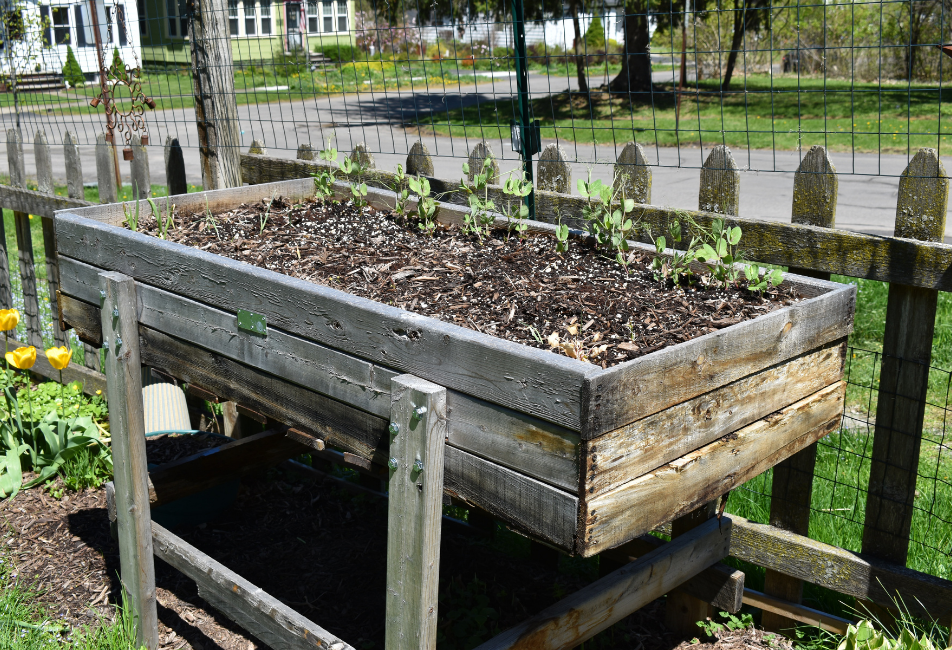
Just sprouting sugar snaps line the back of the planter so when taller, they can climb up the fence. In front of the snaps are two small sections of leek starts and a row of tiny chard seedlings make up the the front. Photo by Emily Johnson.
Sales in the garden building materials, nurseries, equipment, and stores sector increased by 8.6% from June 2019 to June 2020, according to the U.S. Census Bureau. In fact, so many people began gardening that seed supplies ran dry. Seed companies shut down orders to accommodate the influx. The W. Atlee Burpee & Co, according to Reuters, sold more seeds in March 2020 than any other time in its 144 years of operation. Gardening provided a space for isolated individuals to nurture themselves in the arms of nature. With COVID’s unpredictability and induction of fear, gardens became havens for health, both physically and emotionally. Ashmita Das, a masters candidate in the Department of Environmental Science at SUNY ESF, launched her graduate research project with a desire to understand the impact of COVID-19 on community gardens. The feedback from 30 gardeners in Syracuse and Binghamton wove together a theme of connection: to nature, to oneself, and each other. “So many people I spoke to brought up this idea that their garden was a place to watch positive things happen,” Das says. “The emotional fulfillment of caring for something from seed to fruit actually has a lot of mental health benefits, which is an increasingly important thing during the pandemic.”
When deaths rose and businesses shut down, the bleakness collectively felt evaporated as gardening provided a space to forget reality momentarily and pour energy and love into. Suddenly, the act of nurturing plants became a tool of sanity during lockdown. A 2019 research study through the University of Exeter found that spending 120 minutes in nature delivered robust physical and psychological benefits. And for a gardener, two hours out of 168 in a week is nothing. “You go out with one task in mind, and before you know it, it’s five hours later,” Woodman says. “Every time you look at something that could be done, you get into a flow. It’s a kind of flow where you don’t think about yourself.”
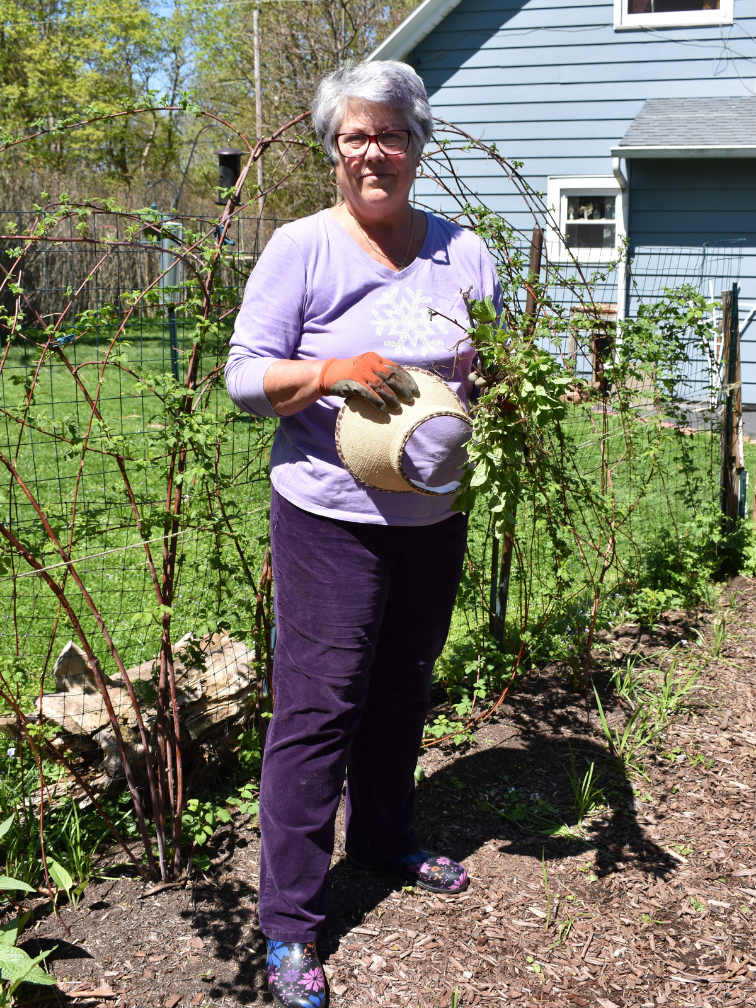
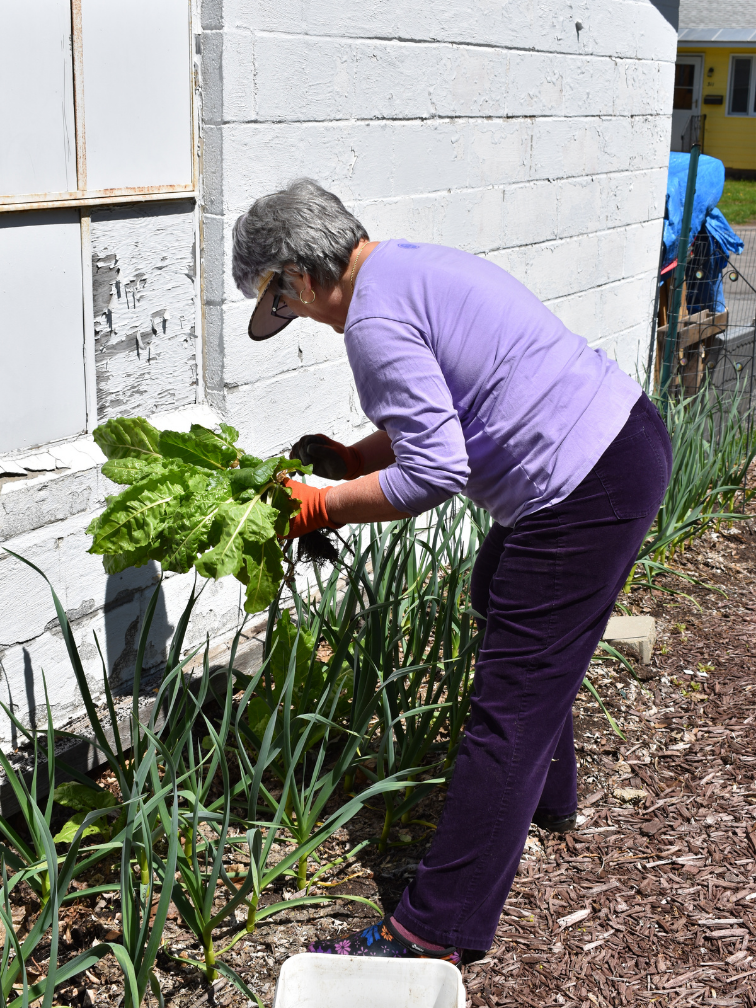
Gardener and writer Jane Woodman spent the past 12 years learning from her garden. Every year she documents where she plants each crop, mapping out from the beds to the germination upstairs. She alters where tomatoes are planted — moving them from the center of the garden to west towards the garage this year. Photo by Emily Johnson.
As labor evolves from drudge to enjoyable, time melts away. Gardening requires physical labor — tilling, plowing, planting, weeding, composting, and even just walking from one side to the other. A 2018 research study published by Sir Richard Thompson, the former president of the Royal College of Physicians, documents how the act of gardening restores dexterity and strength, improves the cardiovascular system, promotes balance, enhances self-esteem and mental health, and counteracts the effects of obesity. He used the study to recommend that doctors prescribe nature and gardening to their patients. “The best evidence is that gentle exercise is just as important as valent exercise for improving your general health,” Richard says. “I’m glad to say it doesn’t have to be vigorous, you don’t even have to run. Just walking or gardening is beneficial.”
There’s a collectivity to gardening — whether that’s among the critters and the sun or beside other gardeners. It cultivates community and becomes therapeutic.
But the act of gardening offers more than an increased heart rate and a good stretch. The soil nourishes us too. Apparently, dirt is an antidepressant. Microscopic creatures build their own ecosystem beneath the soil called Mycobacterium vaccae, or M. vaccae. Dr. Chris Lowry, an associate professor of integrative physiology at the University of Colorado Boulder, researches the relationship between the immune system and the brain, and M. vaccae serves as a key part of that. Dr. Lowry found that mice injected with the isolated M. vaccae experienced reduced levels of stress. He also found those who suffered from anxiety, depression, and post-traumatic stress disorder benefited from the mycobacterium. Exposure to nature for individuals with stress-induced disorders could have profound, positive lasting impacts. And to experience the benefits, you don’t need to consume dirt — just be near it. An October 2020 study in Finland demonstrated that kids exposed to the “forest floor” or nature experienced a reduced chance of catching immune-related illnesses. “Simply being around soil and interacting, the soil is sufficient enough to alter your immune system in a way that can protect you,” Dr. Lowry says.
Soil surrounds Woodman — from her office right out into her backyard. Her raised beds house pounds of soil. On the garden tour, I ran my fingers through brown leaves and a coconut coir perlite mix and filled my lungs with earthy aroma of wood, compost, and dirt. As we walked along the trellises connected to the raised beds that soon would nurture asparagus, Woodman talked about the connection she sees between spirituality, nature, and science. “I don't see a conflict between religion and science or between religion and nature,” Woodman says. “It's all part of the same thing, and that's something that getting to know your soil really well will show you. The sheer amount of life that's out there under the snow is astonishing. And it's there whether we see it or not.”
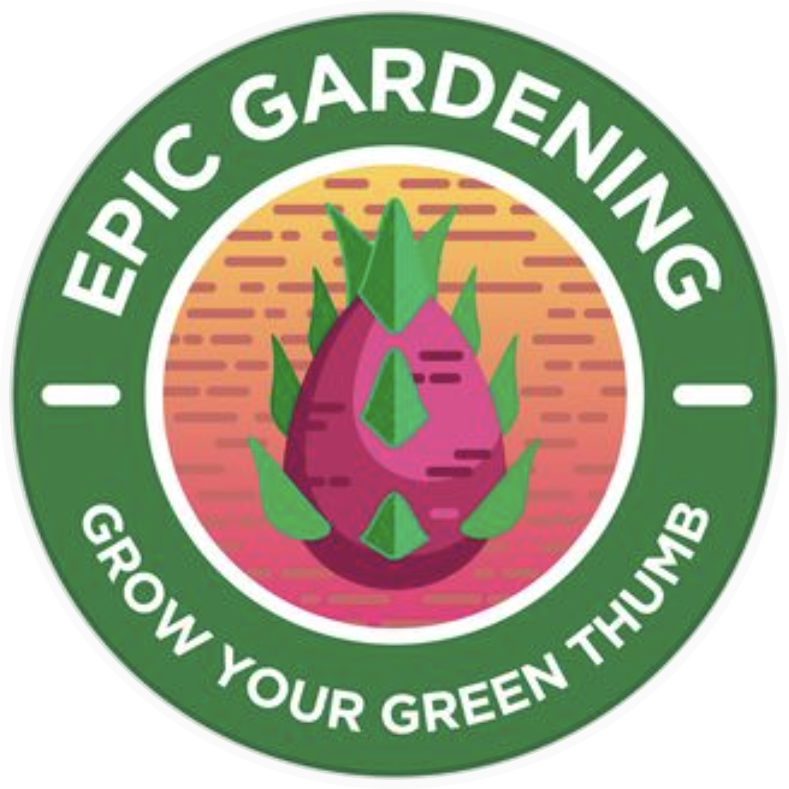
Founder Kevin Espiritu started the company as a hobby in 2013, but transitioned it to his full-time job in 2016, filming how-to videos, creating blog posts, and testing gardening beds. For the more than 1.2 million subscribers on YouTube and 848.8k followers on TikTok, Espiritu provides quick tips for new gardeners and long-term sustainable guides. Its IGTV features more than 200 how-to videos, including essential gardening tools and their care. Check out the tutorials on growing peppers, garlic, pineapples, and potatoes.

Modeled after the popular Instagram account, Humans of New York, this blog launched in 2017 and captures and shares the stories of home gardeners from around the world with the goal of igniting a passion for gardening, sharing food, and tending to the environment. With 286k Instagram followers, the account connects the gardening community transnationally. Those featured (from homemakers to doctors) share their stories on how they came into gardening, what’s important to them, and how community is built.

Houston-resident and urban gardener Timothy Hammond (“Big City Gardener”), encourages followers to “Just Grow It.” He began his account in April of 2017 with the goal of making gardening accessible. He encourages people to grow their own food and provides tips across his social media to do it. With 74k Instagram and 63.7k TikTok followers, his content ranges from creating D.I.Y. garden projects to farming, urban gardening, container-gardening hacks, and teaching followers how to make red pepper flakes or kombucha. On YouTube, Hammond started a Beginner Gardening Series that features 12 videos under 10 minutes.
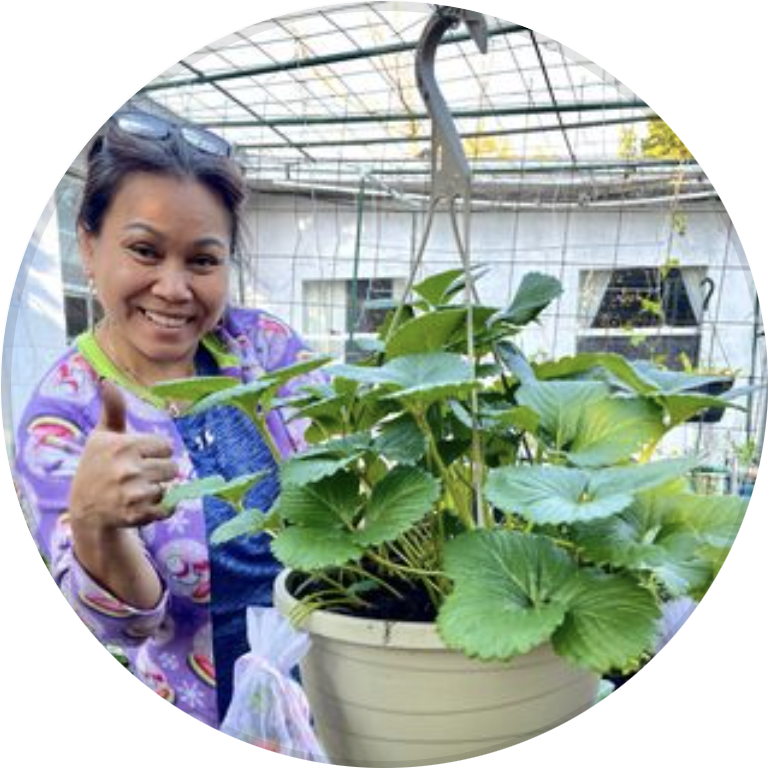
Judy Bao (“Mama Judy”) possesses 25 years of gardening experience in Florida. Her son, Thong, began posting videos of her gardening techniques on Instagram and TikTok, where she earned some viral success. She teaches her 482.9k followers on TikTok (with more than 4.8 million likes) and 29.1k followers on Instagram how to repot bamboo or snake plants and why it’s important to bury an egg in the soil to deliver extra nutrients. Since December 2020, viewers have watched her grow okra from seedling to harvest, remove dragon fruit seeds, tend to her corn crop, and plant grapes.
Behind the garage, Woodman pointed at the garlic scapes shooting from the soil. Tens of bulbs laid in rows, with a hole adjacent to the white-stained wood of the garage. The hole was hidden between the soil, leaves, and towering garlic stalks. A nest of bunnies resided within it, the mother bunny protecting her kin from predators. Whomever is rolling this cycle of life, Woodman says, she’s damn grateful to bear witness to it during Trump’s presidency and the pandemic.
Woodman spent her adult life as a writer and poet. She graduated with a master’s in literature from the University of Central Florida in 1980 and taught writing, literature, and linguistics in the English Department of her alma mater for eight years, then at Johns Hopkins Center for Talented Youth online for 23 years. “I remember being struck when I was in graduate school by the thought that if you've dug down deep enough, under any discipline, you'll find they were all connected,” Woodman says. She sees this embedded in her garden.
In a self-published poetry collection from 2016, Necessary Language: Free Verse on Five Themes, “Growing Seasons” serves as one of the five themes. The last stanza of “Spring Song” reads: “Wisps of clouds decorate that blue dome / Vegetable reflections shot into the upper world / Reminding everything that it’s all ruled by the sun / By the same sun that browns my skin while I grow / Roots from my feet deep into soil to join the garlic.” Yet, throughout the past five years of political turmoil and pandemic existentialism, Woodman couldn’t find it in herself to write. It was the life of the garden that kept her rolling.
There’s a collectivity to gardening — whether that’s among the critters and the sun or beside other gardeners. It cultivates community and becomes therapeutic. Hilda Mechthild Krus, the director of the Horticultural Society of New York's GreenHouse Program on Rikers Island Correctional Facility, believes in the importance of horticultural therapy, or plant therapy. The program teaches incarcerated individuals the basics of gardening. The society provides the necessary tools, seeds, and equipment for the garden, and those in the program decide the crops, tend to the garden, and engage with one another as a community. “I think the benefit of being in a garden together and taking care of land brings people together,” Krus says. “We are all in this garden together, and there is a shift — we are all just people maintaining land together.”

On the southeast corner of the Woodman’s lot there is a fenced off garden, with mounds of mint, Glencoe black raspberry vines, barely secure wooden fencing holding potatoes, and garlic sprouts. Everything in the garden has a second life — either repurposed palettes built into raised beds or found along side of the road and made into containers and pseudo trellises. Photo by Emily Johnson.
On the other side of the country, Cathrine Sneed, founder of The Garden Project, implemented a similar program at the San Francisco County Jail San Bruno Complex in the 1980s. Sneed saw how ex-convicts failed to receive help once they were released. In 1992, she founded The Garden Project to employ ex-convicts and to support them post-release. The organically grown fruits and vegetables harvested from the Carroll Street Garden in Hunters Point are donated to restaurants, communities, and people across the city. In the 33 years since its conception, The Garden Project has provided jobs to more than 1,000 people. “It would not have been had it been anything other than gardening,” Sneed says. She taught her employees how to plant seeds, till, harvest, make compost, and care for the growth of the plants. From prisoners to ex-prisoners to disadvantaged youth, Sneed worked with a diverse group of people planting, caring, and growing together. “Working, and particularly working with plants and being a gardener, you have power that you don’t have otherwise,” Sneed says. “The power to change things, to make them better, to make them different — with your hands.”
Anthony Travis Jr. echoes that sentiment. He believes gardening transformed his life. Travis Jr. met Sneed in the 1980s when he gardened at the San Bruno Complex garden. After his release for the second time, he found no jobs or programs available to help him grow except for The Garden Project. “I wanted something different,” Travis says. “By the time I had the opportunity to show someone that I do want to work, she gave me that opportunity.” Travis Jr. worked with both The Garden Project and the Tree Corps, a program that planted more than 10,000 street trees in San Francisco. “I was planting little baby trees, and now I can go back to those trees right now and look at them,” Travis Jr. says. “There are big tall trees, strong trees, and I can climb up some of them. I planted these trees. I planted them.” After years of gardening, he now works as the chief steward for the Union 261 and as a General Foreman for the San Francisco Public Utilities Commission Department and continues to garden in his own backyard and volunteer in community gardens.
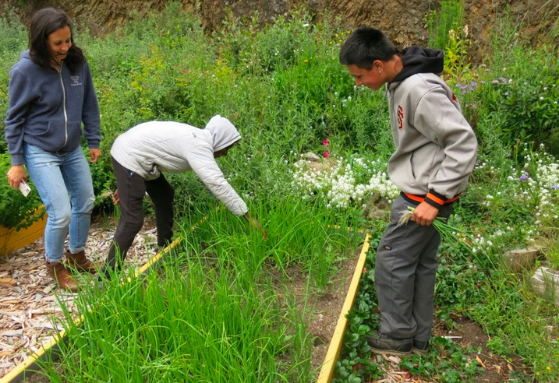
Members of The Garden Project harvest green onions from a container bed. Founder Cathrine Sneed believes planting seeds happens with plants and people. “What I know about seeds is that they grow when the conditions are right. When they have the right light, when they have enough air, when they have enough water — they grow. That’s true for us. That seed is going to grow if we get what we need to help the growth happen.” Courtesy of The Garden Project website.
In fact, Sneed defines what she does as cultivating hope. And that work takes on a greater importance when hard times arrive — 38-year-old Veronica Moore discovered that when she experienced profound loss. “Gardening is a part of my fabric,” Moore says. But as a child, and despite having a mother who surrounded their homes with plants, she failed to recognize the healing afforded from plant care. But in 2018, when her sister passed away unexpectedly, Moore found herself needing a therapeutic grieving process. After a year spent in traditional therapy, she turned to dirt and growing green things. “Traditional talk therapy was preparing me to love again; it was preparing me to nurture things again, it was preparing me to heal my heart,” Moore says. “All through plants, all through watching the plants grow, all through making the adjustment that needs to be made in order for the progress of the plant.”
Caring for plants transformed into comfort, and she wanted to share that experience to enrich others’ lives. In April of 2020, Moore launched her Instagram, Brown Skin Plant Mama, as a place for people to learn about plant therapy and engage in topics surrounding the plant community. Her account boasts 11,800 followers, and she hosts an IGTV series, Plant Therapy is Real, where she and another member of the plant community discuss plant therapy, plant love and care, and the experience of being Black both in the plant community and in greater society.
On March 8, Moore and Kamili Bell Hill, the founder of @blackpeople.wplants and @plantblerd, laughed about plant care and gardening technology, and discussed the lack of representation in the plant community. Bell Hill founded Black People With Plants in June of 2020 after the death of George Floyd to showcase Black plant caretakers with joy and happiness. In late May and early June, other plant pages featured Black Lives Matter content and Black planters and pledged to include Black voices following Floyd’s death, but went back to their page weeks later like nothing occurred. Black planters vanished from #Plantstagram feeds as if anti-racist due diligance was achieved. Bell Hill took matters in her own hands. “That’s how Black People With Plants was born” Bell Hill says. “Just a love letter to Black planters.” The page has more than 28,000 followers with over 2,000 reposts of Black planters. Her plant pages grew a community. “We live in a society so driven by technology,” Bell Hill says. “And here we are reconnecting with nature in a way that I think is so important.” Social media is known for its isolating qualities but Bell Hill sees the virtual plant community as the connective tissue to begin and strengthen friendships.
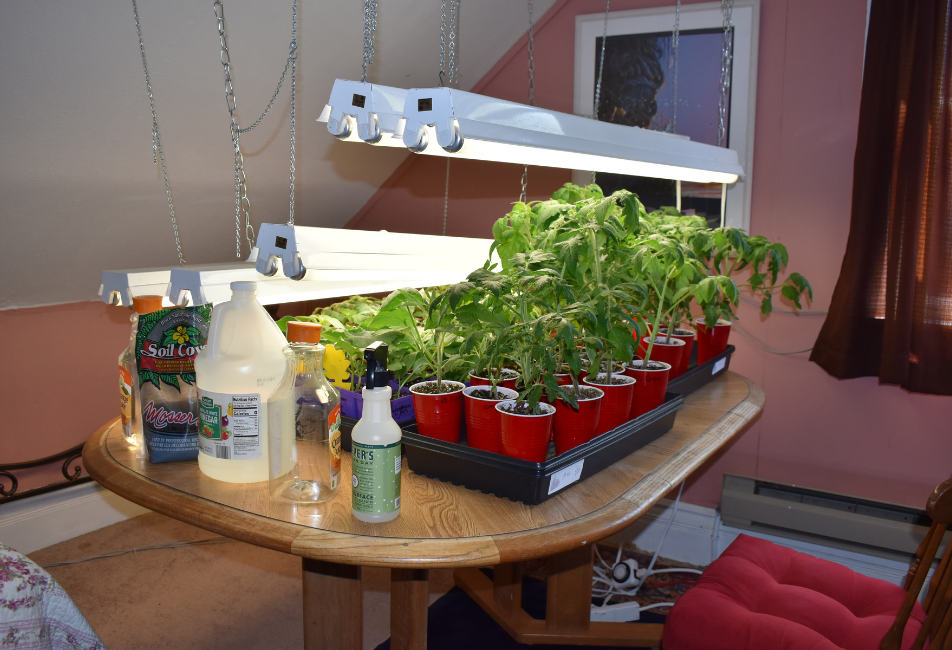
Tomatoes, peppers, and failed microgreens begin germinating in the Woodman’s office. Shop lights hang on adjustable chain links and move farther up as the plants grow. Soon, those tomatoes will be hardened off and planted in the garden. Photo by Emily Johnson.
Plant therapy informs the personal and professional pieces of Moore’s life. Her website, launched in October 2020, includes guides for new plant buyers and incorporates plant therapy into schools. The program is designed to teach young students, from preschool to eighth grade, plant care and plant therapy. Moore first taught her four-year-old daughter, Hunter, the importance of plant care as it imparts lessons of responsibility and attention to detail. What began as an initiative in Hunter’s classroom, transformed into providing plants to over 300 students and teachers in Lehigh Valley. “We’re able to teach children at a young age the benefits and what they can learn from plant care,” says Moore. “This is an exercise, an opportunity, to teach children in a different way.” Any child, she believes, can learn how plants are emotionally beneficial. For Moore, pruning, the act of cutting away dead plant matter, serves as her favorite type of plant care. “When I see a leaf turning yellow or brown, I’m ready to clean it and to give that plant a bit of fresh air,” Moore says. “Like ‘oh this dead weight is off of me.’” And that act serves as a metaphor for self-care too. “The dead weight that we remove from our lives like the mess or the toxic people or environments,” she says. “when we remove those things from our being, we are free to grow, and we can prosper.” For Moore, gardening represents the physical labor of removing the grime from our own lives and benefits from an intentionality that comes from slowing down, looking at what is new, and reflecting.
As I walked through Woodman’s garden, she pointed to the dead leaves serving as a pillow for a planter. The worms love it, apparently. And when the worms munch on it, the soil is nourished and ready to be rooted. In that same soil, I shoveled holes to plant different types of potatoes. As I dug, I hit a rock that emerged with eyes and scalloped skin. A chameleon-like grey-brown toad croaked next to my shovel, and Woodman exclaimed it was the same one she bothered a few hours before just a few feet away at the end of the planter. It had migrated and burrowed again. I planted potatoes in rows. Woodman shoveled compost on top of the top layer of soil and potatoes before dousing them in water. The toad watched, sharing the space, as we worked to grow next year’s worth of stews and home fries. Silence took over the space as we each let our minds wander and our hands connected to the earth. Then, we turned towards the soon-to-be tomatoes.

Our pursuit of outdoor joy is remiss without the acknowledgement of the occupation of unceded Indigenous land. We are students and journalists working, writing, and living on the land of the Haudenosaunee Confederacy, comprising the Six Nations made up of the Mohawk, Onondaga, Oneida, Cayuga, Seneca, and Tuscarora nations. However, acknowledgement is not enough. Read More.